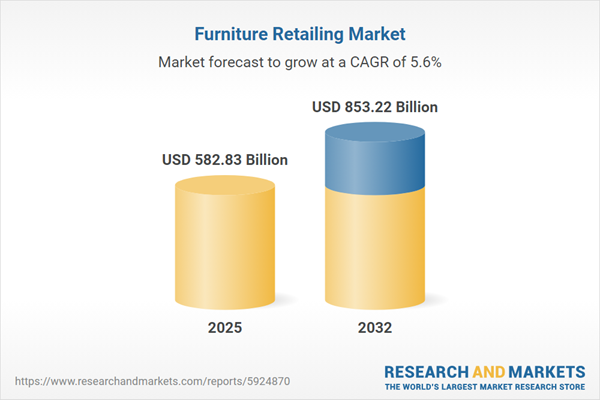Speak directly to the analyst to clarify any post sales queries you may have.
The furniture retailing market is undergoing significant transformation as senior leaders prioritize digital initiatives, process innovation, and supply chain agility to stay ahead in an evolving regulatory and customer landscape. Flexible business models and advanced technologies are now central themes for organizations striving to secure growth and resilience.
Market Snapshot: Furniture Retailing Market Size and Growth
The global furniture retailing market is estimated at USD 552.51 billion in 2024, with expectations to reach USD 582.83 billion in 2025 and a forecast of USD 853.22 billion by 2032. The compound annual growth rate (CAGR) stands at 5.58%. Key drivers include broad digital adoption, sophisticated analytics, and the refinement of supply chain processes, empowering retailers to meet diverse customer and enterprise requirements. The integration of automation and real-time data is enabling more responsive operations, supporting stronger competitive positioning as the commercial and residential sectors evolve.
Scope & Segmentation: Strategic Levers in Furniture Retailing
Understanding scope and segmentation is crucial for leaders aiming to pinpoint opportunities and navigate regulatory variation across regions. Tailored investments and precise market targeting drive meaningful returns in a competitive environment. The following segments and dynamics underpin strategic decision-making in the furniture retailing space:
- Product Categories: Executives must balance portfolios spanning bedroom, living room, kitchen, office, and outdoor furniture to address comprehensive contract and residential demands.
- Material Types: The choice among wood, composites, metal, and plastic supports both sustainability goals and the user experience, impacting lifecycle management and environmental positioning for businesses and consumers alike.
- Distribution Channels: Blending digital platforms with brick-and-mortar spaces ensures flexible fulfillment and enhanced customer journeys as digital sales become more prevalent.
- End Users: Serving both business buyers looking for high-function work environments and households seeking versatile, stylish options fosters product innovation and deepens brand relationships.
- Regional Coverage: Customizing strategies for the Americas, EMEA, and Asia-Pacific allows companies to address unique cultural considerations and regulatory requirements, enhancing scalability and operational effectiveness.
- Leading Companies: Studying the approaches of organizations such as Ingka Holding, Kingfisher, Wayfair, and Ashley Furniture reveals proven strategies in process improvement, innovation, and market segmentation that inform best practices across the sector.
Cutting-edge manufacturing and digitally enabled supply chain operations are increasingly integral for organizations seeking resilience. The use of automation and data analytics enhances risk management and delivers the real-time insights necessary for agile strategy and enduring success across global furniture retail channels.
Key Takeaways for Furniture Retail Executives
- Adopting comprehensive omnichannel strategies drives higher customer engagement by providing a unified brand presence across digital, physical, and mobile touchpoints.
- Improving supply chain transparency aids in meeting organizational sustainability targets and enables smoother adaptation to evolving regulatory standards regionally.
- Prioritizing the rollout of modular and adaptive product solutions equips organizations to respond flexibly to emerging workplace and lifestyle trends for both B2B and consumer audiences.
- Targeting tailored offerings to client segments supports more robust customer relationships and facilitates market expansion into new channels or demographic groups.
- Designing supply chain processes that accommodate unique local market demands strengthens operational continuity and ensures tailored solutions for commercial, interior, and exterior applications.
- Encouraging collaboration between suppliers and retailers accelerates technology adoption and ensures effective responses to changing compliance requirements across regions.
Tariff Impact: Navigating 2025 Trade Policy Shifts
Forthcoming adjustments to United States tariff policies in 2025 present a pivotal challenge for furniture retail leaders. To manage new risks and ensure supply continuity, organizations are emphasizing supplier diversity, nearshoring opportunities, and closer vendor partnerships. These approaches position companies to rapidly adjust sourcing and logistics strategies as trade policy changes unfold.
Methodology & Data Sources
This analysis draws from executive interviews across manufacturing, logistics, and retail, and incorporates findings from regional consumer studies. Reliable industry data, company disclosures, and established analytical tools—including SWOT and PESTEL models—provide a robust foundation for actionable insights.
Why This Report Matters
- Empowers decision-makers to allocate resources, guide product initiatives, and enter emerging markets with confidence.
- Equips organizations to anticipate and plan for technological and regulatory changes using practical scenario modeling and risk-aware planning tools.
- Delivers clear visibility into digital transformation and evolving buyer trends, supporting adaptable strategies that enhance competitiveness.
Conclusion
Leveraging digital innovation and actionable insights, furniture retail executives can strengthen growth, uphold compliance, and ensure sustained operational agility in a rapidly shifting global marketplace.
Additional Product Information:
- Purchase of this report includes 1 year online access with quarterly updates.
- This report can be updated on request. Please contact our Customer Experience team using the Ask a Question widget on our website.
Table of Contents
3. Executive Summary
4. Market Overview
7. Cumulative Impact of Artificial Intelligence 2025
Companies Mentioned
The companies profiled in this Furniture Retailing market report include:- Ingka Holding B.V.
- ADEO S.A.
- Kingfisher plc
- Wayfair, Inc.
- Williams-Sonoma, Inc.
- Ashley Furniture Industries, LLC
- JYSK A/S
- La-Z-Boy Incorporated
- RH Holdco, Inc.
- Ethan Allen Interiors, Inc.
Table Information
| Report Attribute | Details |
|---|---|
| No. of Pages | 184 |
| Published | October 2025 |
| Forecast Period | 2025 - 2032 |
| Estimated Market Value ( USD | $ 582.83 Billion |
| Forecasted Market Value ( USD | $ 853.22 Billion |
| Compound Annual Growth Rate | 5.5% |
| Regions Covered | Global |
| No. of Companies Mentioned | 11 |









